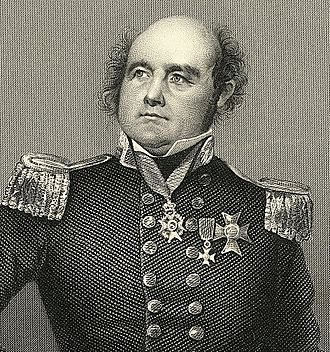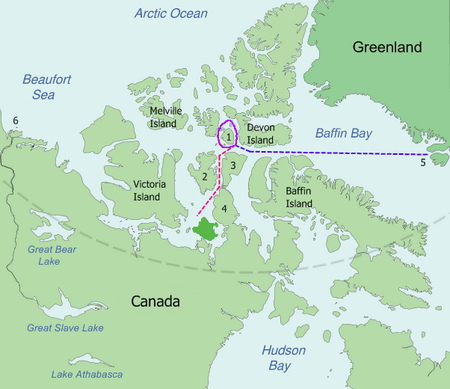John Franklin facts for kids
Quick facts for kids
Rear-Admiral of the Blue
Sir John Franklin
|
|
|---|---|
 |
|
| Lieutenant-Governor of Van Diemen's Land | |
| In office 5 January 1837 – 21 August 1843 |
|
| Secretary | John Montagu |
| Preceded by | Sir George Arthur |
| Succeeded by | Sir John Eardley-Wilmot |
| Personal details | |
| Born | 16 April 1786 Spilsby, Lincolnshire, England |
| Died | 11 June 1847 (aged 61) King William Island, North-Western Territory (now Nunavut, Canada) |
| Spouses |
Eleanor Anne Porden
(m. 1823; her death 1825) Jane Griffin
(m. 1828) |
| Children | 1 |
| Military service | |
| Allegiance | |
| Branch | |
| Service years | 1800–1847 |
| Rank | Rear-Admiral of the Blue (posthumous) |
| Wars | |
| Expeditions | |
Sir John Franklin (born 16 April 1786 – died 11 June 1847) was a brave British Royal Navy officer and a famous explorer of the Arctic. He fought in wars against France and the United States. Later, he led two big trips into the Canadian Arctic. These were in 1819 and 1825.
From 1839 to 1843, he was the Lieutenant-Governor of Van Diemen's Land (which is now Tasmania, Australia). His third and last trip was in 1845. He wanted to find the Northwest Passage, a sea route through the Arctic. But his ships got stuck in ice near King William Island in what is now Nunavut, Canada. Sir John Franklin died there in June 1847. Ten months later, the ships were left behind. Sadly, the whole crew died from things like hunger, extreme cold, and a disease called scurvy.
Contents
Sir John Franklin: A Life of Exploration
John Franklin was born in Spilsby, England, on 16 April 1786. He was the ninth of twelve children. His father was a merchant. John went to King Edward VI Grammar School. He soon became very interested in a life at sea.
His father wanted him to be a church leader or a businessman. But John loved the sea. When he was 12, his father let him go on a trial trip on a merchant ship. This trip made him even more sure he wanted to be a sailor. In March 1800, John joined the Royal Navy.
He served on a ship called HMS Polyphemus. He fought in the Battle of Copenhagen in 1801. This was part of Horatio Nelson's fleet. Later, he went on an expedition to Australia as a midshipman. He was also at the Battle of Trafalgar in 1805. During the War of 1812 against the United States, Franklin was a lieutenant. He was hurt in a battle in December 1814.
In 1818, Franklin commanded HMS Trent. They sailed from London to Spitzbergen. This was part of a bigger expedition.
First Arctic Expedition: The Coppermine Journey
In 1819, Franklin was chosen to lead an expedition. They would travel by land from Hudson Bay. Their goal was to map the north coast of Canada. They would start from the mouth of the Coppermine River and go east.
During this trip, Franklin fell into the Hayes River. A member of his team saved him. This expedition was very difficult. Between 1819 and 1822, 11 out of 20 men in his group died. Most died from hunger or being too tired. The survivors had to eat lichen and even tried to eat their own leather boots. Because of this, Franklin got the nickname "the man who ate his boots."
Marriage and Second Arctic Expedition
In 1823, Franklin returned to England. He married a poet named Eleanor Anne Porden. Their daughter, Eleanor Isabella, was born the next year. Sadly, his wife died in 1825 from tuberculosis.
In 1825, he started his second big trip to the Arctic. This was called the Mackenzie River expedition. This time, the goal was to reach the mouth of the Mackenzie River. From there, he would follow the coast west. Another explorer, Frederick William Beechey, would try to sail northeast from the Bering Strait.
Supplies for this trip were much better organized. Franklin reached the mouth of the Mackenzie River on 16 August 1825. He left letters there for another explorer, William Edward Parry. He then spent the winter at Fort Franklin on Great Bear Lake. The next summer, he went downriver again. He found the ocean frozen. He traveled west for hundreds of miles but had to turn back on 16 August 1826.
Franklin's diary from this trip mentions his men playing hockey on the ice of Great Bear Lake. Because of this, the town of Délı̨nę, built where Fort Franklin was, is considered one of the birthplaces of hockey.
On 5 November 1828, he married Jane Griffin. She was a friend of his first wife and loved to travel. On 29 April 1829, he was made a knight by King George IV. He also received a special Gold Medal from a French geography society.
Governor of Van Diemen's Land
In 1837, Sir John Franklin became the Lieutenant Governor of Van Diemen's Land. He held this job until 1843. He is remembered in Hobart, the capital of Tasmania. There is a statue of him in Franklin Square.
His wife, Lady Franklin, worked to start a university and a museum. The university was built later in 1890. Lady Franklin also helped make the Lieutenant-Governor's private botanical gardens open to the public. The town of Franklin and the Franklin River in Tasmania are named after him.
The Lost Northwest Passage Expedition

After Franklin's second Arctic trip, there was less than 500 kilometers (about 310 miles) of Arctic coastline left to explore. The British decided to send a well-equipped expedition to finish mapping the Northwest Passage. Sir John Franklin, even though he was 59 years old, accepted the command. This would become his famous "lost expedition."
Franklin was the expedition commander. He led two ships, HMS Erebus and HMS Terror. These ships were very strong and had new inventions. They had steam engines that let them move on their own. They also had a special heating system and a way to make fresh water. The ships had libraries with over 1,000 books. They carried three years' worth of food in cans.
However, the company that supplied the canned food was cheap. They rushed to prepare thousands of cans. This meant that lead from the solder used on the cans could get into the food. Also, the water system might have used lead pipes. This could have put lead into the drinking water.
The Franklin Expedition left England on 19 May 1845. There were 24 officers and 110 men. They sailed north to Scotland and then to Greenland. They were last seen by other Europeans on 26 July 1845. They were moored to an iceberg in Lancaster Sound.
It is believed the expedition spent the winter of 1845–46 on Beechey Island. The Terror and Erebus got stuck in ice near King William Island in September 1846. They never sailed again. A note found later on that island said Franklin died there on 11 June 1847. His exact burial place is not known.
After two years with no news, Lady Franklin asked the British Navy to send a search party. The Navy waited another year because the crew had three years of supplies. Then they offered a £20,000 reward for finding the expedition. This money and Franklin's fame led to many searches.
At one point, ten British and two American ships went to the Arctic to look for them. More ships and men were lost looking for Franklin than in the expedition itself. Sad songs, like "Lady Franklin's Lament," became popular. They told the story of Lady Franklin searching for her husband.
In 1850, the first signs of the Franklin expedition were found on Beechey Island. These included the graves of three of Franklin's crewmen. Many people still thought Franklin was alive. He was even promoted to Rear-Admiral of the Blue in October 1852, after he had already died.
In 1854, a Scottish explorer named John Rae learned the true fate of the Franklin party. He talked to Inuit hunters. They told him both ships got stuck in the ice. The men tried to walk to safety but died from the cold.
Rae's report was shared with newspapers. This made many people in Victorian society upset. Lady Franklin was very angry. She worked hard to honor her husband. This led to 25 more searches over the next 40 years. These searches did not find much new information about Franklin's men. But they helped map a lot of the Arctic.
In the 1980s, scientists studied the bodies of the Beechey Island crew. They found that the men likely died from pneumonia and possibly tuberculosis. Tests also showed that lead poisoning might have been a problem.
These studies suggested that a mix of bad weather, being stuck in ice for years, poisoned food, and diseases like scurvy killed everyone in Franklin's group. In 2009, an archaeologist named Robert Grenier found pieces of metal from the 19th century at Inuit hunting sites. He believes these pieces came from the Terror ship.
A newspaper, The Guardian, wrote about Inuit stories. These stories describe starving, tired men walking through the snow. They did not ask the local Inuit people for help. Grenier thinks that some crew members stayed on the ships as they drifted south. One ship broke apart. But Inuit hunters found another ship, probably the Terror, floating in fresh ice. It was neat inside. The Inuit found a tall dead man in a cabin. They took valuable copper and tools from the ship. They also said one of the masts was on fire. Grenier wonders if it was the galley's chimney still smoking from a meal cooked that morning, before the last of Franklin's men disappeared.
Sir John Franklin's Lasting Legacy
For many years after the expedition was lost, people saw Franklin as a hero. He was seen as a leader who tried to find the Northwest Passage. A statue of Franklin in his hometown says: "Discoverer of the North West Passage." Other statues in London and Tasmania have similar words. There is also a memorial for him in Westminster Abbey.
Many places are named after Franklin. These include Franklin Island in Antarctica and Franklin Island in Greenland. There is also Franklin Strait in northern Canada and Franklin Sound near Tasmania. The Franklin River and the town of Franklin in Tasmania are also named for him. A Canadian research ship, RV Franklin, carries his name.
The place where Franklin spent the winter during his second Canadian expedition, in Délı̨nę, was made a National Historic Site of Canada in 1996. One of Canada's old territories was even called the District of Franklin.
In 2009, a special service was held to honor Sir John Franklin. It celebrated the United Kingdom's efforts to map northern Canada. It also remembered the lives lost in exploring new places.
Rediscovery of the Ships
In September 2014, the wreck of HMS Erebus was found. It was in Wilmot and Crampton Bay. In September 2016, the wreck of HMS Terror was discovered. It was in Terror Bay and was in "pristine" (perfect) condition.
The ships were found many miles south of where they were last known to be. Archaeologists believe the Terror must have been sailed to its new location. Its anchor was used, and it was sailed through many islands and channels. These wrecks are now protected as the Wrecks of HMS Erebus and HMS Terror National Historic Site.
Images for kids
-
Engraving of Charles Bacon's statue of Franklin in Spilsby in 1861, before it was put in place.
See also
 In Spanish: John Franklin para niños
In Spanish: John Franklin para niños




